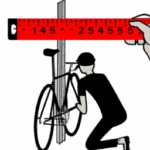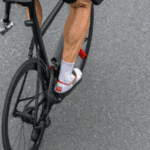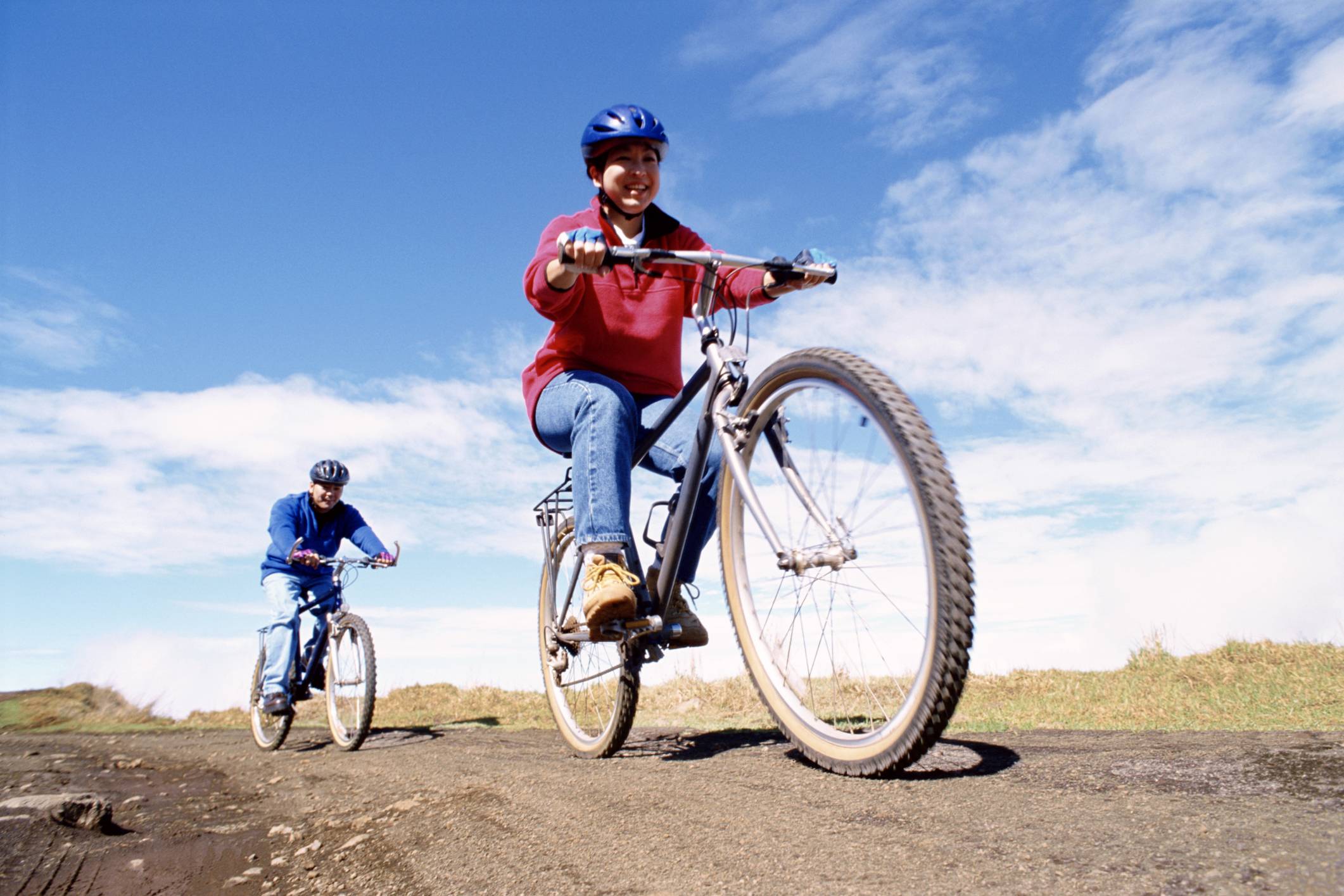Many common cycling injuries, like abrasions, fractures, and overuse pains, happen due to poor bike fit or accidents. Properly adjusting your saddle height, fore-aft position, and handlebar reach helps reduce stress on your knees, back, and shoulders. Wearing safety gear and following safe riding practices further cut injury risks. Staying aware of proper fit and safety can make your rides safer and more comfortable—keep exploring to learn how to protect yourself even better.
Key Takeaways
- Proper bike fit reduces overuse injuries like patellofemoral syndrome by optimizing knee and joint angles during pedaling.
- Correct saddle height and fore-aft position prevent pressure injuries, skin abrasions, and reduce risk of hematomas.
- Adjusting handlebar reach and cleat alignment minimizes upper-body strain and knee stress, lowering musculoskeletal injuries.
- A well-fitted bike promotes biomechanical efficiency, decreasing the likelihood of muscle strains and overuse syndromes.
- Professional fitting addresses asymmetries and improves stability, significantly reducing fall-related skin, head, and clavicle fractures.
Recognizing Common Cycling Injuries

Have you ever wondered which injuries cyclists most commonly face? The answer is a mix of skin injuries, fractures, and head traumas.
Abrasions, lacerations, and hematomas make up 40–60% of cycling injuries, often caused by falls or crashes. Proper protective gear can help reduce these injuries significantly. Additionally, understanding the types of common injuries can help in implementing effective prevention strategies. Being aware of the city traffic environment and riding cautiously can further decrease injury risk. Utilizing essential oils for injury prevention, such as lavender or eucalyptus, can also promote healing and reduce inflammation when injuries do occur.
Fractures account for 6–15%, with clavicle fractures being the most common.
Head injuries, including concussions, make up 5–15%, sometimes resulting from collisions or falls without proper protection. Using properly fitted helmets can significantly reduce the risk of head injuries during cycling accidents.
Musculotendinous injuries like strains affect 2–17.5% of cyclists, often due to overuse.
The most frequent overuse injury is patellofemoral syndrome, impacting the knees.
Recognizing these common injuries helps you stay alert and take preventive steps, especially during high-risk seasons or in urban environments.
Being aware of injury types can also guide you in seeking timely treatment.
The Role of Bike Fit in Injury Prevention
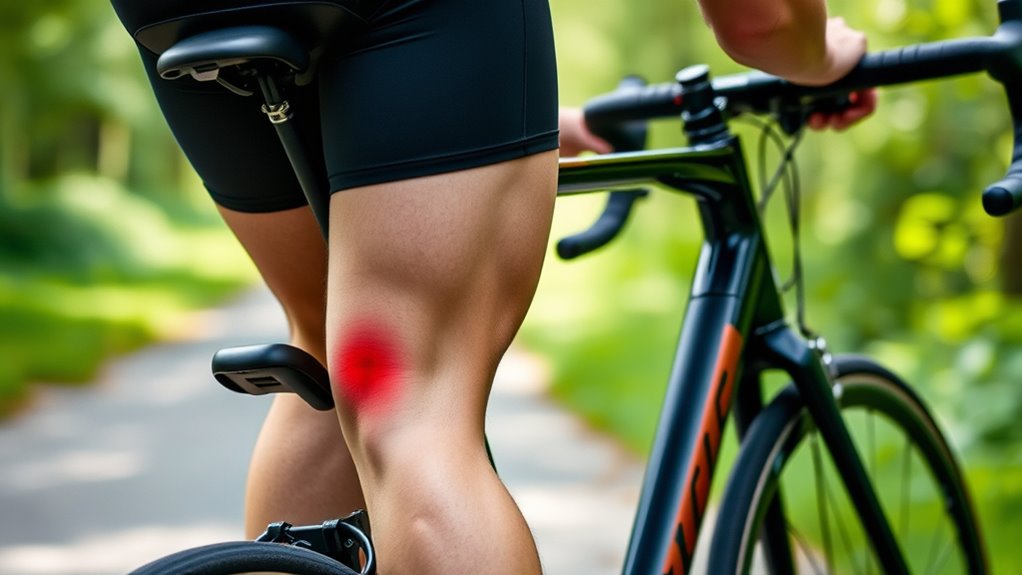
Proper bike fit plays a crucial role in preventing injuries by ensuring your body moves efficiently and comfortably during rides. When your saddle height is set correctly, your knees maintain 25-35° of flexion, reducing patellofemoral stress. Proper saddle fore-aft positioning balances weight between saddle and handlebars, preventing overuse injuries. Adjusting handlebar reach keeps elbows at 90-100° flexion, reducing upper-body fatigue. Neutral cleat alignment minimizes knee strain, while appropriate stack/reach ratios maintain spinal neutrality and improve breathing. A professional fitting enhances comfort and biomechanical alignment, decreasing pain and injury risk. It also addresses asymmetries in pelvic contact and foot stability, preventing unilateral pain and arch collapse. Using pimple patches can be an effective part of a skincare routine to treat blemishes and prevent further skin issues. Additionally, paying attention to muscle imbalances can help prevent overuse injuries by ensuring all muscle groups work harmoniously during cycling.
Essential Gear for Safety and Injury Reduction
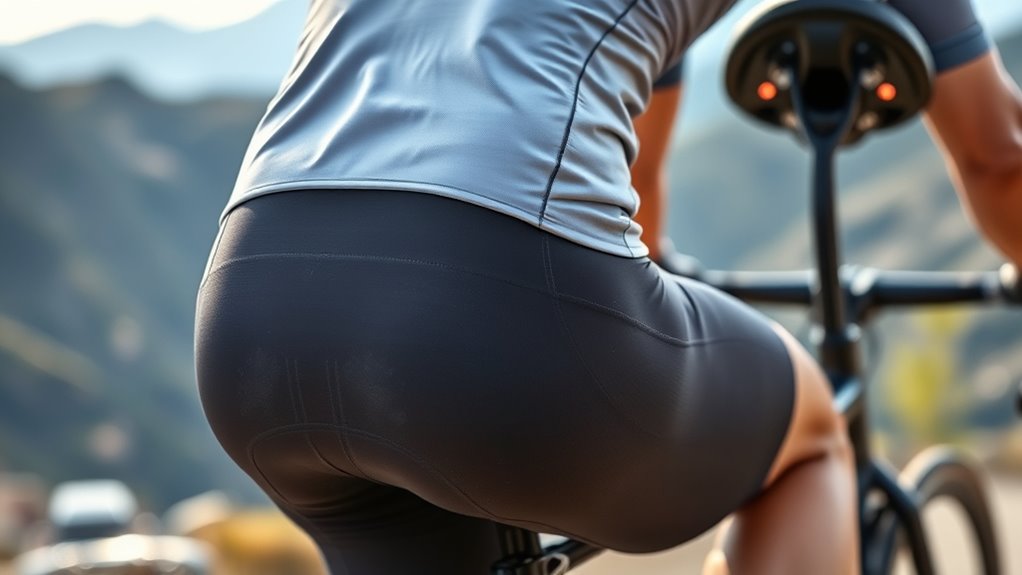
Ensuring you have the right safety gear can considerably reduce the risk of injuries while cycling. A helmet is essential, offering head protection and cutting injury risk by up to 60%. Vetted helmets are recommended by professionals for safety and durability. Gloves prevent abrasions and improve grip, making rides safer and more comfortable. Lights and reflectors boost visibility in low-light conditions, while reflective gear increases your overall visibility to drivers and other cyclists. Carrying a first-aid kit allows you to treat minor injuries promptly. Protective clothing like padded shorts or a wicking jersey enhances comfort and prevents chafing. Eye protection shields your eyes from debris and sun glare, and mirrors help you stay aware of your surroundings without turning your head. These gear essentials create a safer cycling experience and help minimize injury risks.
Training Strategies to Minimize Risk

Implementing targeted training strategies can considerably reduce your risk of cycling injuries by enhancing strength, flexibility, and biomechanics. Focus on single-sided exercises like split squats and single-leg deadlifts to correct cycling-specific imbalances.
Incorporate core activation drills, such as planks and Russian twists, to stabilize your posture and lessen lower back strain. Strengthen your glutes and hips to improve pedaling efficiency and prevent knee valgus.
Use mobility routines like dynamic stretches before rides and static stretches afterward to maintain flexibility. Foam rolling and thoracic spine drills help reduce tightness and improve posture.
Additionally, paying attention to suction power and proper equipment fit can support injury prevention by ensuring your bike setup promotes optimal biomechanics and reduces undue stress.
Follow a progressive overload plan, balancing high-intensity efforts with recovery. Cross-training and active recovery rides prevent overuse, keeping your body resilient and injury-free during long cycling seasons.
Tips for Safe Cycling Practices

To stay safe while cycling, you need to prioritize pre-ride preparation and stay alert on the road. Always wear a helmet to protect your head in case of falls.
Prioritize pre-ride checks and stay alert for a safer cycling experience.
Regularly inspect your bike’s tires, brakes, and chain to guarantee everything functions properly.
Use reflective gear and wear weather-appropriate clothing to boost visibility and comfort, especially at night.
Plan your route to avoid heavy traffic and hazards.
Maintain a straight line while riding and stay in bike lanes, avoiding parked cars and the “door zone.”
Use hand signals for turns and changes.
Watch for driver signals, brake lights, and blind spots to anticipate their actions.
Ride predictably, yield to pedestrians, and stay focused on traffic signals.
Keep distractions to a minimum for safer rides.
Frequently Asked Questions
How Often Should I Check My Bike Fit Adjustments?
You should check your bike fit regularly to stay comfortable and prevent injuries. If you ride over 2,000 miles a year, do it once a year.
Reassess if you experience saddle pain, numbness, back, neck, or knee pain.
Also, check after any significant weight or fitness changes, getting a new bike, or if you notice mobility shifts.
Regular fit checks keep you riding smoothly and safely.
Can Improper Gear Selection Cause Long-Term Injuries?
When you choose gears that aren’t quite right, you might be setting the stage for longer-term issues. Using too high or low gears can put unnecessary strain on your knees, back, and muscles, gradually leading to discomfort or injury.
What Are Early Signs of Overuse Injuries?
You might notice early signs of overuse injuries like localized pain around your knees, neck, or lower back during or after riding. Tenderness along joints or tendons, dull aching in hips or shoulders, and sharp twinges during pedal strokes are common.
You could also feel stiffness after rest, early fatigue in specific muscles, or reduced performance. Paying attention to these signals lets you adjust your bike fit and training before issues worsen.
How Does Cycling on Different Terrains Affect Injury Risk?
Cycling on different terrains puts your body to varied tests—riding mountain bike parks pushes your speed and risk, road cycling challenges your joints with repetitive strain, gravel surfaces demand constant micro-adjustments, and indoor studios test your posture and endurance.
Each terrain shapes your injury risk differently—faster speeds increase collision severity, uneven surfaces threaten falls, and poor fit amplifies overuse.
Adapt your riding style and equipment to match each terrain’s unique demands.
Are There Specific Warm-Up Routines to Prevent Common Injuries?
You should incorporate specific warm-up routines to prevent injuries. Start with off-bike dynamic stretches like leg swings, bodyweight lunges, and arm circles to boost mobility.
Then, do on-bike gradual intensity efforts—easy spins, tempo rides, and short sprints—to activate muscles and increase blood flow.
Focus on quadriceps, glutes, and core exercises to prepare your body for riding. These routines help minimize strain and reduce injury risk during your cycling session.
Conclusion
By paying attention to your bike fit, gear, and training, you can steer clear of injuries and keep your cycling journey smooth. Think of your body as a finely tuned engine—when all parts work together seamlessly, you’re unstoppable. Remember, safety isn’t just a stop sign; it’s the open road ahead. Embrace proper practices, and let your passion for cycling lead you to endless adventures without setbacks. Your best ride is still ahead.



